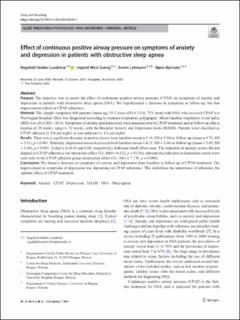| dc.contributor.author | Lundetræ, Ragnhild Stokke | |
| dc.contributor.author | Saxvig, Ingvild W. | |
| dc.contributor.author | Lehmann, Sverre | |
| dc.contributor.author | Bjorvatn, Bjørn | |
| dc.date.accessioned | 2021-05-10T11:05:56Z | |
| dc.date.available | 2021-05-10T11:05:56Z | |
| dc.date.created | 2020-11-09T11:30:05Z | |
| dc.date.issued | 2020 | |
| dc.Published | Sleep and Breathing. 2020, 1-7. | |
| dc.identifier.issn | 1520-9512 | |
| dc.identifier.uri | https://hdl.handle.net/11250/2754622 | |
| dc.description.abstract | Purpose
The objective was to assess the effect of continuous positive airway pressure (CPAP) on symptoms of anxiety and depression in patients with obstructive sleep apnea (OSA). We hypothesized a decrease in symptoms at follow-up, but that improvement relied on CPAP adherence.
Methods
The sample comprised 468 patients (mean age 55.5 years (SD = 12.0), 72% men) with OSA who received CPAP at a Norwegian hospital. OSA was diagnosed according to standard respiratory polygraphy. Mean baseline respiratory event index (REI) was 28.4 (SD = 20.6). Symptoms of anxiety and depression were assessed prior to CPAP treatment and at follow-up after a median of 20 weeks, range 6–52 weeks, with the Hospital Anxiety and Depression Scale (HADS). Patients were classified as CPAP adherent (≥ 4 h per night) or non-adherent (< 4 h per night).
Results
There was a significant decrease in anxiety scores from baseline (mean = 5.16, SD = 3.94) to follow-up (mean = 4.76, SD = 3.81), p < 0.001. Similarly, depression scores decreased from baseline (mean = 4.31, SD = 3.66) to follow-up (mean = 3.89, SD = 3.69), p < 0.001. Cohen’s d (0.19 and 0.18, respectively) indicated small effect sizes. The reduction in anxiety scores did not depend on CPAP adherence (no interaction effect F(1, 466) = 0.422, p = 0.516), whereas the reduction in depression scores were seen only in the CPAP adherent group (interaction effect F(1, 466) = 7.738, p = 0.006).
Conclusions
We found a decrease in symptoms of anxiety and depression from baseline to follow-up of CPAP treatment. The improvement in symptoms of depression was depending on CPAP adherence. This underlines the importance of adherence for optimal effect of CPAP treatment. | en_US |
| dc.language.iso | eng | en_US |
| dc.publisher | Springer | en_US |
| dc.rights | Navngivelse 4.0 Internasjonal | * |
| dc.rights.uri | http://creativecommons.org/licenses/by/4.0/deed.no | * |
| dc.title | Effect of continuous positive airway pressure on symptoms of anxiety and depression in patients with obstructive sleep apnea | en_US |
| dc.type | Journal article | en_US |
| dc.type | Peer reviewed | en_US |
| dc.description.version | publishedVersion | en_US |
| dc.rights.holder | Copyright The Author(s) 2020 | en_US |
| cristin.ispublished | true | |
| cristin.fulltext | original | |
| cristin.qualitycode | 1 | |
| dc.identifier.doi | 10.1007/s11325-020-02234-7 | |
| dc.identifier.cristin | 1846081 | |
| dc.source.journal | Sleep and Breathing | en_US |
| dc.identifier.citation | Sleep and Breathing, 2020. | en_US |

